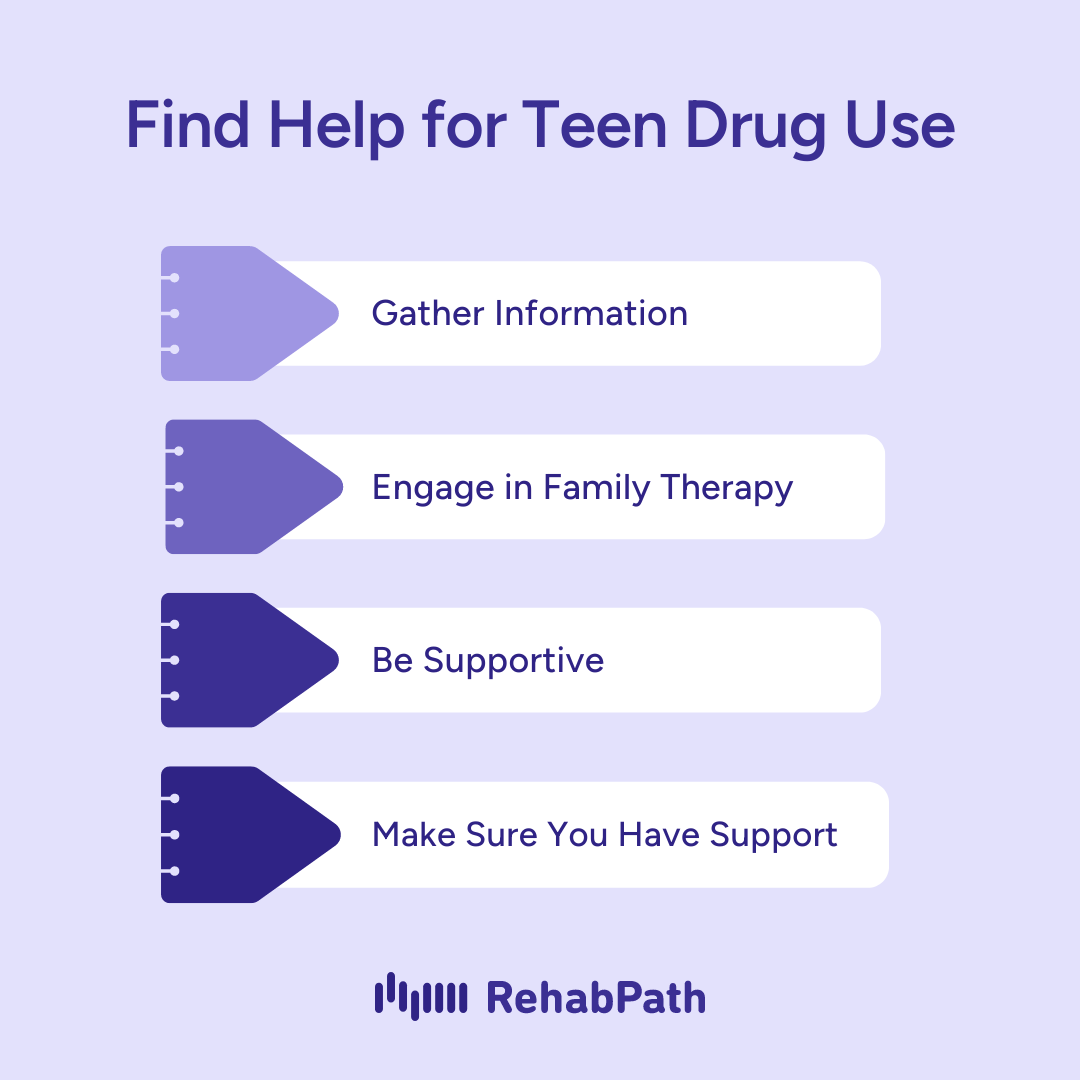Learn / The Signs of Drug Use in Teens
The Signs of Drug Use in Teens


July 6th, 2023| Clinically Reviewed by
Key Points
- If you're concerned about your teen, learn more about ways you can spot drug use.
- Teen drug use is still an issue, and often they experiment to fit in socially.
- You can find help for your child to stop the cycle today.
Drug use in teens is an increasing problem in the U.S. It’s important to recognize the signs of drug use in order to intervene and help teens struggling with addiction. Common signs of drug use in teens include changes in behavior, including mood swings, attitudes, and school performance. Additionally, physical signs can include red eyes, changes in sleep patterns, and changes in physical appearance. Finally, teens with drug addiction may show signs of financial or legal trouble, including stealing money or getting into trouble with the law.
If your child is using drugs, this recovery journey you’re about to embark on can not only help your teen, but it can also make your whole family grow closer. Getting teen treatment can set your child on the path to success.
Signs, Symptoms, and Behaviors of Drug Use in Teens
If you know what to look for, you can discover if your teen is using drugs or drinking alcohol. Be on the lookout for these signs:
Changes in mood:
- Irritable
- Withdrawn
- Unable to focus
- Depressed or hyperactive
Changes in appearance:
- Unkempt appearance
- Bloodshot eyes
- Flushed cheeks
Changes in behavior:
- Sneaking out
- Secretive about their phone or their whereabouts
- Missing school or work
- Hanging out with a new crowd of friends
How to Spot Drug Use in Teens
If you have a hunch your kid is using drugs, but you want to be sure, there are some things you can do to get a better idea of the situation:
- Have eye contact conversations, and see if their eyes are bloodshot.
- Smell for smoke.
- Pay attention to their emotional state, this may be out of the norm.
- Go through their belongings: This can be a sensitive topic. Giving your children the privacy they deserve is important, but if you are concerned about your teen’s safety and well being due to possible drug use, you may want to consider this option.
Explore Adolescents Treatment Centers
Teen Drug Use Statistics
According to the National Institute on Drug Use, since the start of COVID-19, reported drug use has decreased1. This is likely due to school closure and social distancing (i.e. less peer pressure). Luckily, the downward trend has continued through the last couple of years; however, substance use still poses a threat.
The Most Commonly Used Drugs Amongst Teens
The most commonly used drugs reported in 2022 were nicotine/vaping, cannabis/marijuana, and alcohol. (Keep in mind that these are only the reported statistics. More teens likely use these substances and just don’t report it.)
- 20.5% of 10th graders vaped
- 19.5% of 10th graders ingested cannabis
- 15.2% – 31.3% of 10th graders drank alcohol
While this downward trend provides some hope, research findings show dramatic and rising death rates in youth between the ages of 14-18.
Also, it’s important to know that fentanyl, amongst other dangerous players, has contaminated the U.S. and worldwide drug supply2. This substance is extremely potent, meaning even the tiniest drop can make the user overdose. Fentanyl could be found in drugs like cocaine, MDMA (ecstasy), and heroin because it’s cheaper to cut these drugs with fentanyl than sell the pure substance.
Educating yourself on these dangers, and knowing how to help your child, is crucial for prevention, awareness, and recovery if/when needed.
Reasons Why Teens Use Drugs
Each teen has their reasons for using drugs. Here are some common factors that can push them to experiment.
- Peer Pressure: Being a teenager is hard, and they just want to fit in with their peers. If their best friend, or someone they admire, offers them drugs or alcohol, they’ll likely take it to feel accepted.
- Media: TV shows, movies, and especially social media nowadays can show drug use as glamorous, normal, or fun. This can appeal to impressionable teens.
- Self-Medication: Mental health issues start to pop up around adolescence, and some teens may see the escape of drugs as a way to avoid these complex feelings.
- Experimentation: Teens are curious and ready to try new things, especially as they start to gain some freedom.
- To Feel Grown Up: Wanting to be a grownup and assert their independence can lead them to drinking or doing drugs.
Find Help for Teen Drug Use
So you’ve had the conversation with your teen about their drug or alcohol use. Now is the time to start gathering resources on how to help them.
- Gather Information: Begin by browsing programs for teens. Think through what you want to get out of this experience—for your child and your family. You may want to look for gender-specific care. These programs address hardships that boys and girls uniquely experience by giving them tools to face uncomfortable emotions and experiences. Gender-specific care also helps them focus on treatment without distractions.
- Engage in Family Therapy: Family therapy will likely be an important part of the recovery process, for your teen and your whole family. Addiction education for loved ones is usually offered with this, as well. This gives clarity on your teen’s journey with substances and recovery. So when your child comes home after treatment, everyone will have the skills they need to maintain a healthy recovery environment.
- Be Supportive: Most importantly, be a rock for your child. They’re likely going through a confusing time, so having your support will make this process easier and improve their chances of success.
- Make Sure You Have Support: Give yourself grace through this journey. Helping your child through addiction recovery can be emotionally draining. You will have support from medical professionals, but other family members or friends can also provide support in this process.
4A. Remember to prioritize your own self-care. Engage in activities that bring you joy and practice stress-reducing techniques.
As your kids grow older and start making their own decisions, you can act as a compassionate guide and lead by example. What you do from here on out is what matters most. A bright future awaits for your child with the right teen treatment.

-
Abuse, N. I. on D. (2022, December 15). Most reported substance use among adolescents held steady in 2022. National Institute on Drug Abuse. https://nida.nih.gov/news-events/news-releases/2022/12/most-reported-substance-use-among-adolescents-held-steady-in-2022
-
Friedman, J., Godvin, M., Shover, C. L., Gone, J. P., Hansen, H., & Schriger, D. L. (2022). Trends in drug overdose deaths among us adolescents, January 2010 to June 2021. JAMA, 327(14), 1398–1400. https://doi.org/10.1001/jama.2022.2847
Return to Resource Library
Our Promise
How Is RehabPath Different?
We believe everyone deserves access to accurate, unbiased information about mental health and addiction. That’s why we have a comprehensive set of treatment providers and don't charge for inclusion. Any center that meets our criteria can list for free. We do not and have never accepted fees for referring someone to a particular center. Providers who advertise with us must be verified by our Research Team and we clearly mark their status as advertisers.


















